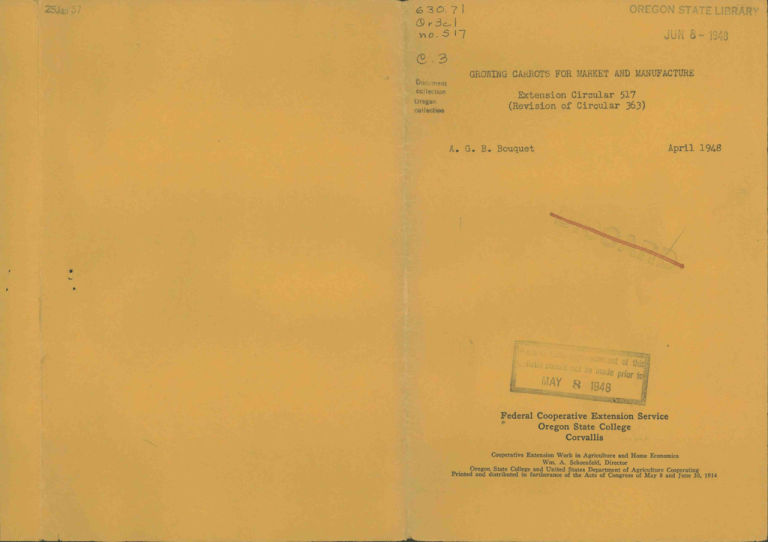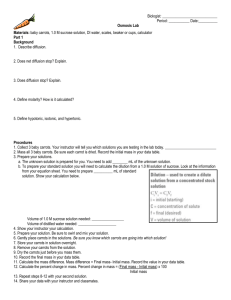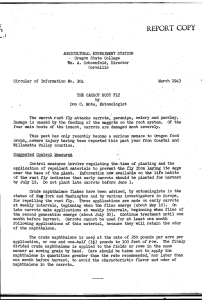vo. 5 April l94 Circular 517 Circular 363)
advertisement

-7 r3cj vo. 5 GROWING CAtROTS FOR MARKET AND MANUFACTURE DOCument ColIect4on Oregari iOI cteii Extension Circular 517 (Revision of Circular 363) A. G. B. Bouquet April l94 p Federal Cooperative Extension Service Oregon State College Corvallis Cooperative Extension Work in Agriculture and Home Economics Wm. A. Schoenfeld, Director Oregon State College and United States Department of Agriculture Cooperating Printed and distributed in furtherance of the Acts of Congress of May 8 and June 30, 1914 Oi3c.( Op!:G0P4 no.5 C-. oCU OREGON April 1948 Extension Circular 517 coLLEcTlol(Revlsion of Circular 363) GROWING CARROTS FOR MARKET AND 1ANUFACTURE By A. G. B. Bouquet Horticulturist (Vegetable Crops) Carrots have become an increasingly consumed article of food in recent years. The acreage of carrots as a truck crop for shipment has increased from 9,770 acres in 1923 to 43,500 acres in 1939 and 80,670 acres in 1946. Much of this change has been due to an increase in shipments of bunched carrots grown in southern states. Carlot shipments of carrots have increased from 1,773 cars in 1921 to 27,796 cars in 1945. Statistics regarding the acreage of carrots grown for processing in the United States are not available, but the pack of canned carrots has increased from 239,930 cases in 1931 to 3,417,502 cases in 1946. The above figures do not include diced carrots mixed and canned with peas. Oregon began canning carrots in 1919 with a pack of 2,650 cases, which had In 1930, 137,137 cases were increased in 1926 and 1927 to over 100,000 cases. canned. Then followed a period of five years of a low pack which did not in any one year exceed 86,000 cases. In 1936 the canned production reached 139,172 cases, 291,166 cases in 1937, and 789,716 cases in 1946. Oregon packs by far the largest amount of carrots canned in the West, which packs about onethird to onequarter of the national total. Carrots are frozen to some extent hut represent the smallest commercial frozen item in the vegetahie pack. The Oregontashington figures of 1945 indicate 2,056,000 pounds of carrots were frozen, and peas and carrots together represented 2,874,000 pounds. The total frozen pack of carrots for the U.S. was approximately 6,051,000 pounds in'1945 and 5,322,000 pounds of peas and carrts. Several thousand cases of carrot juice are packed each year in Oregon. Carrots are a good source of vitamins A, B and C, as well as being fairly rich in carbohydrates. Ecperirnents in Iowa indicate that the cortex or outer portion of the carrot is richer in sugar and food value than the core, and that the outside The vitamin A value of skin is the richest of all parts of the root in vitamin B. mature carrots has been found to be twice that of young carrots. Climatic and Soil Conditions. The carrot prefers moderately cool conditions for its bestdevelopment, although the young plants will thrive during the warm weather of the summer. By far the greatest development of the roots takes place during the months of September and October, following the occurrence of fall rains, -2 The normal rainfall of western Oregon is usually insufficient to induce a maximum yield of carrots without irrigation unless the crop is planted on soil that is Continuous rain coupled with warm weather in the unusually retentive of moisture. fall may cause considerable cracking of roots, especially in fields where there was no irrigation. The root is liardy to light fall frosts but must be protected when the weather shows several degrees below freezing for a continuous period. The average freezing point of topped carrots in storage is 29.60 F, Carrots grow well on almost any kind of soil which is in reasonably good physical condition, but the heaviest yields of the smoothest roots are obtained from sandy and silt loam soils and organic lands. The roots are smoother and more Organic soils are highly retentive of moissymmetrical when grown in a loose soil, ture, so it is possible to grow a large tonnage of carrots on them without irri.On sandy and silt loam land irrigation is desirable to provide a uniform gation. degree of moisture for the entire growing season. It is especially important that the land be reasonably free from weeds. However, oil spraying is now counteracting the influence of weeds on the young carrot plants. The Influence of Environment on Plant and Varietal Characteristics. In 1iscellaneous Publication 361, of the U. S. Department of Agriculture, regarding "Descriptions of Types of Principal American Varieties of OrangeFleshed Carrots," considerable data are presented regarding the influence of temperature and soil on the characteristics of the carrot plant and root. Of particular interest is the influence of temperature upon maximum root development and growth, which probably occurs between 65 and 700 F. or several degrees lower than the optimum for foliage growth. In addition to hereditary factors that may cause branched or forked roots, there ae a number of environmental factors that have a marked influence on the shape of carrot roots. The presence of undecayed manure or plant refuse in the soil results in branching or divided roots, and soils of heavy texture produce more mis shaped roots than those of a lighter or more open texture, Branched or forked roots may also be caused by an injury to the young tap root or by any impediment to its downward growth, In the case of Redcore Chantenay, low soil moisture and low soil phosphorus resulted in roots being more pointed than where optimum amounts were supplied. The root shape of carrots seems to be affected to a considerable degree by The typical shape of the Redcore Chantenay variety is most air temper.ture, read&ly produced when the roots are grown at a constant temperature of approximately 659 F. When grown at a mean temperature of approximately 550, the roots have been longer and more slender, and when grown at approximately 750 they were shorter and less slender, Although Nantes is a longer, more slender and nearly cylindrically shaped variety, the temperature has essentially the same effect as on Chantenay. The smoothness of the root surface is influenced greatly by environmental conditions. Excessive moisture following a period of water shortage may frequently result in white corky outgrowths at the points of side root emergence. There is also considerable influence of environment on the color of carrots. By means of chemical methods it is possible accurately to determine the effect of different growth conditions on the carrot root color. The total color as measured by the carotene content is in general decreased by continuous temperatures above -370° F, and below 600. Roots grown at a mean temperature of than those grown at 650 and the exterior color of the roots Growing the plants at a mean temperature of about 450 after enlarge resulted in still poorer total color, Cool nights, 450, resulted in a better color than continuous growth at 550 had less total color was much lighter. th roots had started to 450, and warm days, 65 , Carrots grown on sandy soils or soils high in organic matter seem to be of better color than those grown on a silt loam soil, In a soil of moderate fertility, an increase in the amount of different plant food elements failed to increase appreciably the color of the roots. Varying amounts of a 4-12-4 fertilizer had no material influence on color, nor did the addition of a mixture composed of boric acid, manganese sulfate, copper sulfate, potassium iodide, and zinc sulfate, nor 800 pounds per acre of barium chloride, fertilizers varying widely in percentages of nitrogen, phosphoric acid and potash. The carrot root as it Development of Shape and Color of Carrot Roots. increases in age and size changes in color from a yellowishr.wIdte when very young to whitish-yellow, light yellow, dark yellow, and orange, according to the variety. These changes in color are due to the accumulation of carotene which appears in varying intensities, producing the orange or orange-red color, In fairly uniform strains the larger roots usually have a higher concen. tration of carotene than the smaller roots o the same age, while in mixed stocks the larger roots are liable to be lighter colored. In uniform strains the smaller, old roots usually have more carotene than younger roots which are larger. Carotene is first laid down in the oldest cells of the cortex and then in the oldest cells of the core. The rate of increase in color depends to some extent on moisture and temperature but usually increases most rapidly during the early part of It is not known how long the increase in carotene will continue the plant growth. under optimum conditions, but records have shown that it increased up to 142 days of age in the Redcore Chantenay variety, The increase in diameter of the carrot is most rapid at the top or crown of the root and as the plant becomes older, the lower portion of the root increases in diameter in varieties where this change is characteristic. In tests of eating quality, sugar content and color intensity, data of the New York Experiment Station indicate superiority of "old" or fully grown carrots over young bunched carrots. Carrots delivered to processing plants are, therefore, most likely to be fully equal if not superior to bunched young roots. Soil Fertilization and Preparation. Unless the manure is well rotted and the weed seeds are rotted out of it, it is not advisable to use barnyard manure previous to sowing carrot seed. It would be preferable to use such material for a crop the previous year. Many of the commercial soils iscd in growing carrots are high in organic matter, hence no added manure is necessary, In the case of sandy loam soil, the turning under of green manures would be advantageous in providing organic matter. The crop is one which removes a considerable amount of potash from the soil. In a 2ton crop of roots, figures indicate removal of 90 pounds of nitrogen, 50 pounds of phosphoric acid, and 200 pounds of potash. If a commercial fertilizer is used, therefore, it should be one which carries a moderately high per cent of potash as well as a reasonable ratio of nitrogen and phosphoric acid. A fertilizer having a ratio of 1-3-3 should be suitable for this crop. Such a fertilizer might have an analysis of four per cent nitrogen, 12 per cent phosphorus, and 12 per cent potassi um, of which 500 pounds and upward might be broadcasted per acre, This application would be considered as being a trial one, to indicate the effect of the fertilizer on the ensuing crop. It seems desirable, also, to apply some commercial borax to carrot land to aid in preventing internal blackening or breakdown. A minimum of thirty pounds per acre may be mixed with the commercial fertilizer used for the crop and applied in (See also paragraph under Crop Disorders.) the manner discussed below. There are two alternative methods of applying such a fertilizer - one, broad casting it before planting, the other being a side dressing of the fertilizer in a The latter method would re band alongside the rows after the plants can be seen. duce the amount of fertilizer necessary by possibly 50 per cent. Carrots are not very tolerant of an acid soil and grow best in-a pH range of between 6,0 and 6.5. A well prepared seedbed is necessary for the sowing of carrot seed for the seeds are small and the seedlings are comparatively weak, It is necessary, there fore, to have a soil that is loose and friable, which will not crust after a rain, Previous to seeding, the soil should have such plowing and disking followed by harrowing and leveling so as to be in fine mellow condition for a good seedbed. If the land is to be irrigated, it will have to be properly leveled for the passage of water from the main ditch to the ends of the rows, This will be unnecessary in the case of water being distributed by overhead sprinkling. Seeds. The most widely grown variety of carrots Varieties, Seed Strains for processing purposes is the Redcore Chantenay. This variety is characterized by a medium long root that tapers slowly from the neck downward, terminating abruptly The roots at the bottom, being what is known as half long, thick and stump rooted. should be deep reddish orange, 5-1/2 to 6 inches long, about 2-1/4 inches thick at the shoulder, tapering but stump rooted. The core is a reddish orange, almost the same color as the flesh, and quite inconspicuous, which is desirable in a carrot for canning or freezing, Nantes is a variety having a cylindrically shaped root of even diameter from End neck to base. Roots are 5 to 6 inches long. Core is small and inconspicuous. of root is blunt, The flesh is of a deep orange color and of fine texture and flavor, For the open market, long, smooth, tapering roots such as of Imperator and Morse's Bunching are preferred. Nantes is also popular, especially for a pre packaged offering. Fresh seed is desirable for planting carrots for it does not have a long viability. The grower should know something about the germination of the seed before planting so as to adjust the number of pounds of seed sown accordingly. The amount of seed used per acre varies from 2 to 4 pounds, depending upon the size of carrots desired and the distance between rows0 Planting at a distance of 20inch rows and growing carrots for slicing or dicing purposes, three pounds of seed are desirable to make a uniform stand with no thinning necessary. The amount of seed used will -5 also be dependent upon the type of soil. Where the soil is loose arid readily pene trated by roots, a thicker seeding can be used than when the soil is heavier, for the roots can then not shove out toward the sides of the rows. Some growers plant in rows 24 inches apart, but if the land is heavier and apt to be weedy, the disSome plantings of market carrots are spaced ig tance between rows may be wider, inôhes between rows. Most of the planting for carrots grown for canning or freezing in western Oregon is done between April 20 and the first week of two in flay but plantings may be made up to June 15 if there is plenty of moisture available and deliveries can be made later in the 5eason, Market carrots are planted as early in the spring as Storage carrots are usually planted in soil and weather conditions are favorable. the late spring. Maintenance, The work of eliminating weeds is one of the most important In recent years this has been accomplished very largely items in growing car.'ots. by applying oil to the carrot fields when the plants and weeds are quite small. In a survey of operations of some 31 carrot growers in 1946, it was found that the cost of weeding the carrot field was over twice as great where weeding with oil was not carried on. The cost of oil weeding in general was found to be about $6.00 per acre. The number of applications of oil varied from one to two times. About 45 gallons of oil were used at one application. According to Circular of Inforniation No. 424, growers who oiled their fields weeded them for about onehalf the cost of those not using oil. Cultivation between the rows is done mainly for the purpose of keeping the soil in good physical condition, for weed elimination, and for possible control of moisture. Irrigation is especially desirable for carrots in providing a uniform amount of moisture during the growing season, inducing a steady growth of the plants and roots, increasing yields, and making it possible for the roots to reach the best size for harvesting at the proper season, There is also less danger of the roots cracking in the fall when the rains begin if the roots have been irrigated. In Oregon Experiment Station Circular of Information No. 424, the total irrigation costs per acre were cited as $l6,30. These costs were for sprinkler irrigation in the Lillaniette Valley. Insect Pests, Diseases, and 1iscellaneous Crop Troibles. Miong the crop disorders of carrots are maggots, nematodes, soft rot, blackening or breakdown, as well as gophers and moles. The carrot rust fly maggot which has spread considerably in western Oregon in recent years is one of the newest insects to affect this crop. Apparently 3 per cent DPI' applied to the young carrot seedlings has given fair control, DDT applied also in the seed row has given promise of control, Nematodes are microscopic eellike worms that are persistent in the soil and are easily spread. The. small nodule..like galls made by the nernatodes are visible on Soils known to produce carrots the fine roots issuing from the main carrot root. with nematodes on them should not be planted the next year to a crop susceptible to this worm, . The cause of soft rot which induces a complete collapse of the carrot is not yet known. There have been some outbreaks of internal blackening of carrot roots, which in certain fields has done much damage. Compared with the widespread study and knowledge of the breakdown of other kind of roots, such as bets, little is known at the present time concerning this blackening of carrot roots. However, it would seem desirable that 30 to 40 pounds of commercial borax be applied per acre in conjunction with the usual fertilizing program for the crop. Gophers and moles are controlled in the usual manner, either by poisoning or trapping, as the case may be. Bunch carrots are harvested when they have Costs. Harvesting, Yields attained a desirable size. The tops are usually held together by Twistems.tt The number of roots in a bunch depends on the size of the carrots. The standard pack of carrots with tops attached in a lettuce crate is 5 to 5 dozen bunches. U. S. Standards for marketing bunch carrots or carrots with shorttrimmed tops are avai1. able from the State Department of Agriculture, Salem, Oregon. There is a trend in some areas to package carrots with the tops removed and placing the roots in a transparent semi-moistureprocf container. Seemingly there are at least two benefits of such a procedure: (1) The elimination of' the cost of shipping the green tops, and (2) the lengthening of tie shelf life of the packaged carrots, which has been demonstrated to be longer than that of unpackaged roots with the tops attached. U. S. Standards for topped carrots are obtainable from the State Department of Agriculture, Salem, Oregon. The harvesting of carrots for processing extends over a considerable period of time, usually beginning when the cannery or freezing plant can handle the roots, which is corrunonly about the first of October. The season of harvesting roots may extend well into the later portion of the year, U. S. Standards for carrots for processing are contained in a leaflet obtainable from the State Department of Agriculture, Salem, Oregon, Yields of carrots are determined largely by the stand of plants, amount of soil fertility and moisture and freedom from crop disorders. The average planting will produce about 20 to 25 tons per acre but it is not uncommon for certain fields to produce 40 tons or more. Costs of producing carrots, mainly for processing, are summarized in Circular of Inforiration No. 424, Oregon Experiment Station, The data in this publication indicate a total cost per acre of 2l4.80 for the 31 growers interviewed, or a cost per ton of l3.3O. Growers who produced high yields per acre grew a ton of carrots much more econcnical1y than "low...yield" growers. Considering preharvest and harvest costs, labor expenses accounted for 60 per cent of the total cost of growing and harvesting an acre of carrots. -7-. Useful References Descriptions of Types of Principal American Varieties of OrangeFleshed Carrots, U, S. D, A. Misc. Pubi, No, 361. Davis, G, B. and Muimford, D, 0., Cost of Producing Carrots in the Willamette Valley, Oregon. Oregon Experiment Station Circular of Information No. 424, 1948.






